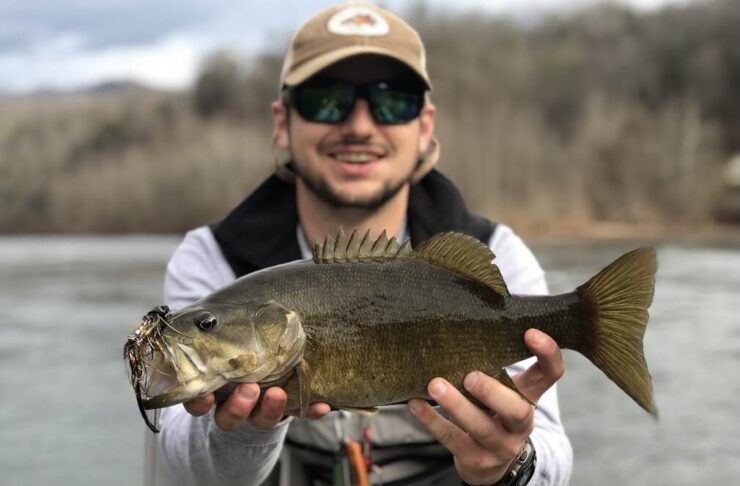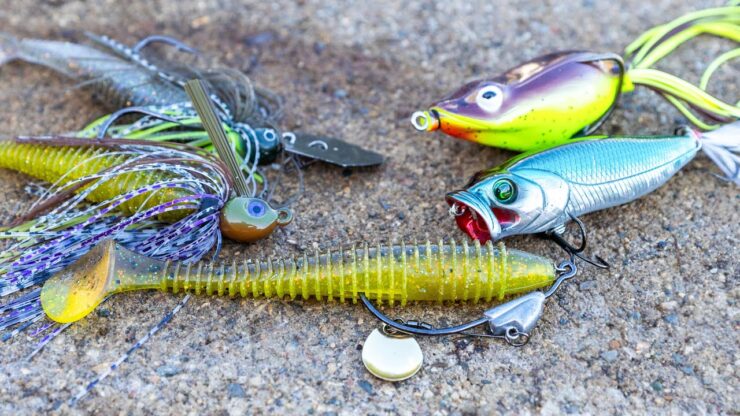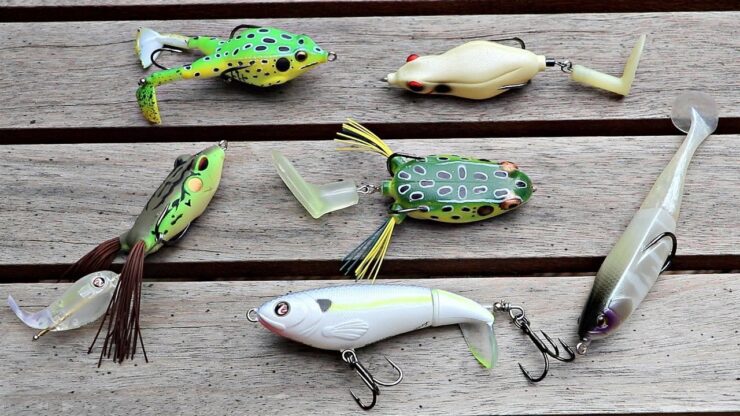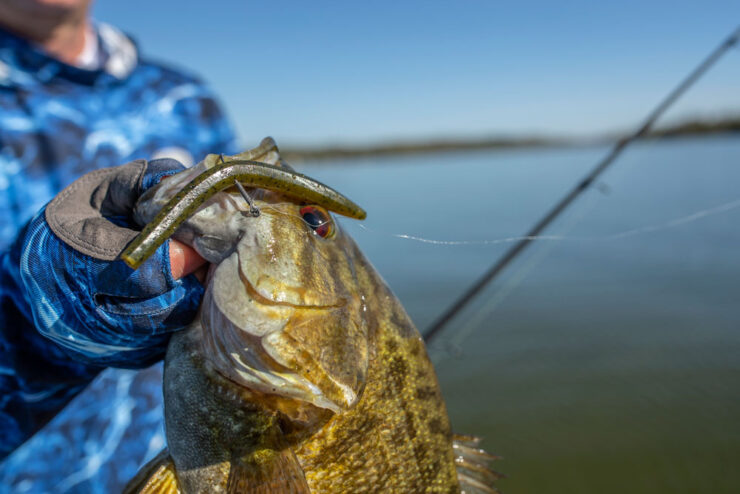Smallmouth Bass are a little pickier than Largemouths about what they eat. Their favorite food is crawfish, so lures that closely imitate them will work. Next on the menu are minnows and other small baitfish. They like worms, but you need to use smaller sizes than for Largemouth Bass. Smallies will eat larger insects like dragonflies and helgramites. Frogs and lizards are not really their cup of tea, but work sometimes. Your best bets are crawfish, minnows, and worms.
Table of Contents
ToggleThe Best Smallmouth Bass Lures
Jigs

For the best chance of success with Smallmouth Bass, it’s really hard to beat a Marabou jig, especially in colors of brown and orange. Other good colors are black, and OD green. The enticing movement of the down feathers in the water is almost irresistible. Plastic-bodied jigs that imitate crawfish and minnows also work well. Next, Tube jigs are an old favorite, and many anglers swear by them. Again, the best colors are those that imitate crawfish. To get the most from jigs, remember, smallmouth bass are more aware of their surroundings than Largemouth Bass, and can be spooked. Cast beyond where you think they are, let it sink to the bottom, then retrieve in short hops.
Spinners
Next on the list of best lures for Smallmouth Bass are French and Inline spinners. Invented in 1938, they are still one of the most productive lures for all species of fish. And the original Mepps is still the king. Next to the Mepps, the Roostertail in Fire Tiger colors is bad news for smallies. And lastly, Panther-Martins in black, brown, or chartreuse colors will get you some fish. Black and brown are also good colors. Just cast past the fish, and reel in just fast enough for the blade to spin. Be careful not to cast directly over the fish, because if you line them, Smallmouth Bass will bolt.
Plastics

A lot of people are of the opinion that soft plastic lures, especially worms, are the ultimate bass bait. And there is evidence to back this up. The original Creme Worm, first introduced in 1951, still tops the list of the 25 Most Influential Bass Lures Of All Time, (and our best bass lures list as well…). Other soft plastics make up over 50% of the remaining lures mentioned. How can a 60+-year-old lure still be #1? Easy. It works, and works well. Soft plastic lures account for more bass, both smallies, and bucketmouths, than all other lures combined. The key is its versatility. They can be rigged Texas-Style, for the most weedless lure there is, Carolina-Style, for more delicate presentations, Wacky-Style to drive bass insane, Drop Shotted for deep bass, or just threaded onto a jig head and fished like any other jig.
- Texas Rig
- Carolina Rig
- Wacky Rig
- Drop Shot Rig
No matter how you rig these, whether it be a worm, crawfish, or generic creature, you can fish them the same way. For Texas Rigs, you usually cast directly into the cover, let it sit for a minute or two, then retrieve it with short, gentle, far-spaced ‘hops’. The same goes for the Carolina Rig, except you can’t really cast directly into heavy cover, but very close to it. The Wacky Rig is fished like the Texas Rig, only unweighted, so it stays suspended in the water column. This is also how you fish Senko and Sluggo worms. The Drop Shot can be fished vertically, or like the Texas rig, only much slower. Rigged on a jig head, plastics can be fished just like any other jig. As to colors, the rule is lighter colors for dark water and dark colors for light water. My personal preference is that any color is OK as long as it is purple. Just my opinion… One thing to keep in mind is that for Smallmouth Bass, you may want to drop down a size or two from your normal largemouth plastic lures. Go to a 5” worm instead of 7 or 8 inches.
Crankbaits
These are great when smallies are in more open or deep water. Floating-Diving models or just plain sinking lures work great. Just size them down one or two notches. Floating-Diving crankbaits work best off of rip-raps, along shoals and rocky bottoms. Just cast them out, and reel them in with a Stop-and-Go retrieve. Let the lure rise back to the surface after each dive before starting the next one. Let it sit on the surface for a minute or 2 each time.
Topwaters

Topwater lures are excellent for fast smallie action, especially in the early morning and evening. Cast them near the cover and let them sit until all the ripples are gone (and be ready for a strike as soon as it hits the water, or sometimes while it is still in the air…). If nothing happens, just pop it in with short twitches, just enough to make noise. Repeat if necessary… Other than the Jitterbug, great choices are the Heddon Chugger, Rebel’s Pop R, the Heddon Crazy Crawler, the Devil’s Horse in smaller sizes, the Crazy Shad, and similar lures.
Other Lures For Smallmouth Bass
Spoons like the Daredevel and the Little Cleo have been catching smallies for decades. I use them for smallies a lot because they definitely work. A well-placed spoon almost guarantees fish. And don’t overlook fly fishing, which in my opinion is the ultimate way to catch Smallmouth Bass. Good fly choices are the Wooly Bugger and Clouser Minnow in brown, OD Green, and orange.
Spoons are easy to make and cheap to purchase, relatively speaking. Kits are available from many Sporting Good suppliers like NetCraft.com, Cabelas, etc… Making your own spinners, spoons, plastics, and lures is a lot of fun and allows you to customize them to your taste. There are hundreds of fly patterns that are deadly on Smallmouth Bass, too many to show here. These are just a few of my favorites. If you are interested in starting out fly fishing for Smallmouth Bass, I’d suggest starting with Wooley Buggers, Clouser Minnows, and Chernobyl Ants. They are easy and inexpensive to tie, and if you have to buy them, they are usually available anywhere flies are sold.
Smallmouth Bass Fishing
Smallmouth Bass fishing can be as addictive as trout. They are everywhere, live in beautiful places, and fight like demons, especially on light tackle. They are great table-fare, and easy to prepare.
Adelaide Gentry, a seasoned kayaking enthusiast and expert, is the driving force behind KayakPaddling.net. With over a decade of experience navigating the world’s most challenging waterways, Adelaide combines her passion for adventure with a deep knowledge of kayaking to provide insightful and practical guidance for paddlers of all levels.
Related Posts:
- Heavy Duty Fishing: 11 Best Rods And Reels For Big Fish 2024
- 12 Best Fishing Lures Ever 2024 - Baits That…
- 16 Best Kayak For Beginners 2024 - Kayaking Adventure Gear
- Can You Eat Largemouth Bass? Absolutely, but…
- 10 Best Saltwater Fishing Boats - Ultimate Angling Adventure
- 12 Best Kayak GPS 2024 - Find Your Way to Adventure












